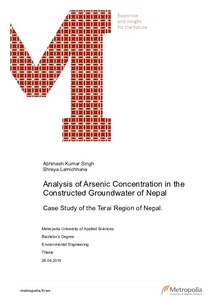Analysis of Arsenic Concentration in the Constructed Groundwater of Nepal
Lamichhane, Shreya; Singh, Abhinash Kumar (2019)
Lamichhane, Shreya
Singh, Abhinash Kumar
2019
All rights reserved. This publication is copyrighted. You may download, display and print it for Your own personal use. Commercial use is prohibited.
Julkaisun pysyvä osoite on
https://urn.fi/URN:NBN:fi:amk-2019052010780
https://urn.fi/URN:NBN:fi:amk-2019052010780
Tiivistelmä
Arsenic (As) is present naturally in the earth’s crust. The high concentration of As in drinking water possesses a great threat to the health condition of people dependent on such sources. Arsenic contamination is a serious problem around the world including Nepal. The impact of arsenic contamination is prominent and severe in the southern lowland of Nepal also known as the Terai region. Though the exact reason for groundwater arsenic contamination is not known, the sediments from Siwalik and the high Himalayas can be considered as a source of As contamination in Terai. Groundwater provides potable water for about 90% of total population in this region. The arsenic contamination has degraded the health of many Nepalese people and thus also reduced the average life expectancy rate.
This thesis mainly deals with the arsenic contamination in the constructed groundwater sources (wells) in Terai Alluvial Land. The goal of this thesis is to analyse the arsenic contamination in constructed groundwater sources. The analysis was done based on the data provided by various national and international organisations such as DWSS, ENPHO and NRCS. The analysis was done to determine the relationship between various factors affecting arsenic concentration in groundwater. The factors include depth of the well, age of the well and the number of people using the well. These factors were compared with As concentration in order to establish the relation between them. Also, further analysis was done to study the population exposed to arsenic poisoning.
The analysis showed that 3 %(> 50μg/l) and 8 % (10-50μg/l) of Terai’s total population are at risk of Arsenic contamination. The analysis revealed that Chitwan (with average As concentration 0.53 μg/l) is the least contaminated district, while Nawalparasi (with average As concentration 18.61 μg/l) is the most contaminated district. More than 2% of wells were contaminated with >50μg/l of As, and about 8 % of samples were contaminated with >10μg/l. As concentration was found to be more in shallow water. However, As concentration decreased with increasing depth. The result indicated that the age of the well and the As concentration are independent of each other. The result also revealed that over-exploitation directly increased the As contamination in wells. The result showed that public wells were slightly more contaminated than private wells and the wells used for school, colleges and offices were found to be more contaminated than other user types. The drinking water is not safe in most part of the Terai region; hence alternative water resources need to be identified as soon as possible. The possible mitigation techniques which are prevalent in Nepal and which every person under the threat of arsenic contamination should use are also discussed in the thesis. There is room for further analysis if enough data on pH changes, climatic factor and concentration of other elements such as Fe and Mn is provided as As concentration also depends on these factors as well.
This thesis mainly deals with the arsenic contamination in the constructed groundwater sources (wells) in Terai Alluvial Land. The goal of this thesis is to analyse the arsenic contamination in constructed groundwater sources. The analysis was done based on the data provided by various national and international organisations such as DWSS, ENPHO and NRCS. The analysis was done to determine the relationship between various factors affecting arsenic concentration in groundwater. The factors include depth of the well, age of the well and the number of people using the well. These factors were compared with As concentration in order to establish the relation between them. Also, further analysis was done to study the population exposed to arsenic poisoning.
The analysis showed that 3 %(> 50μg/l) and 8 % (10-50μg/l) of Terai’s total population are at risk of Arsenic contamination. The analysis revealed that Chitwan (with average As concentration 0.53 μg/l) is the least contaminated district, while Nawalparasi (with average As concentration 18.61 μg/l) is the most contaminated district. More than 2% of wells were contaminated with >50μg/l of As, and about 8 % of samples were contaminated with >10μg/l. As concentration was found to be more in shallow water. However, As concentration decreased with increasing depth. The result indicated that the age of the well and the As concentration are independent of each other. The result also revealed that over-exploitation directly increased the As contamination in wells. The result showed that public wells were slightly more contaminated than private wells and the wells used for school, colleges and offices were found to be more contaminated than other user types. The drinking water is not safe in most part of the Terai region; hence alternative water resources need to be identified as soon as possible. The possible mitigation techniques which are prevalent in Nepal and which every person under the threat of arsenic contamination should use are also discussed in the thesis. There is room for further analysis if enough data on pH changes, climatic factor and concentration of other elements such as Fe and Mn is provided as As concentration also depends on these factors as well.
